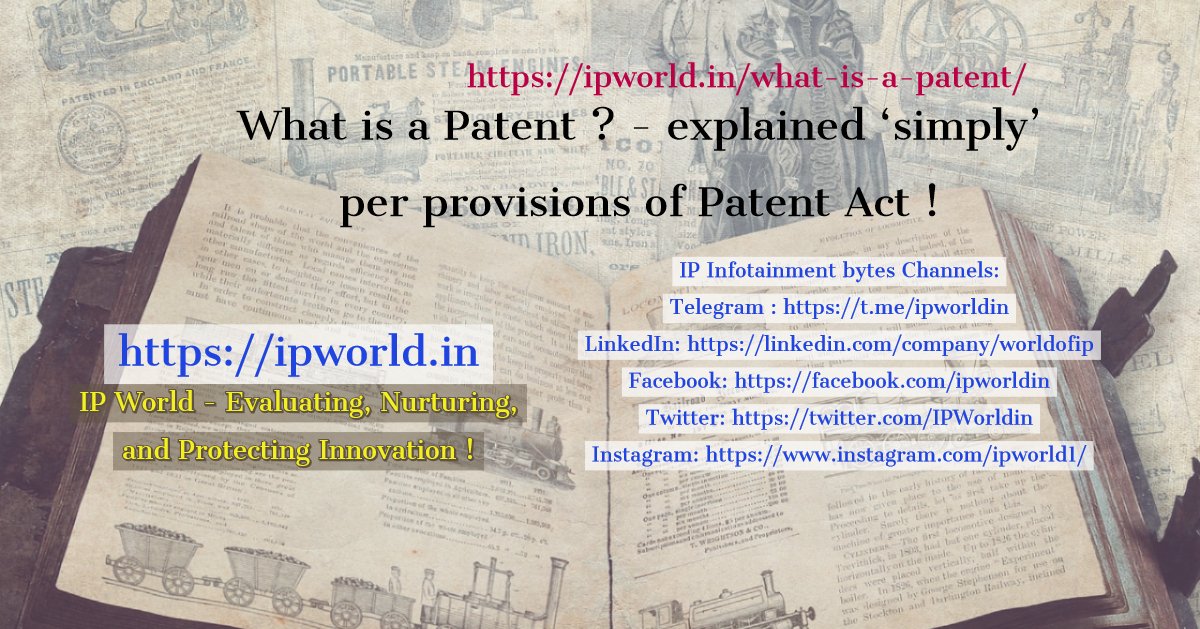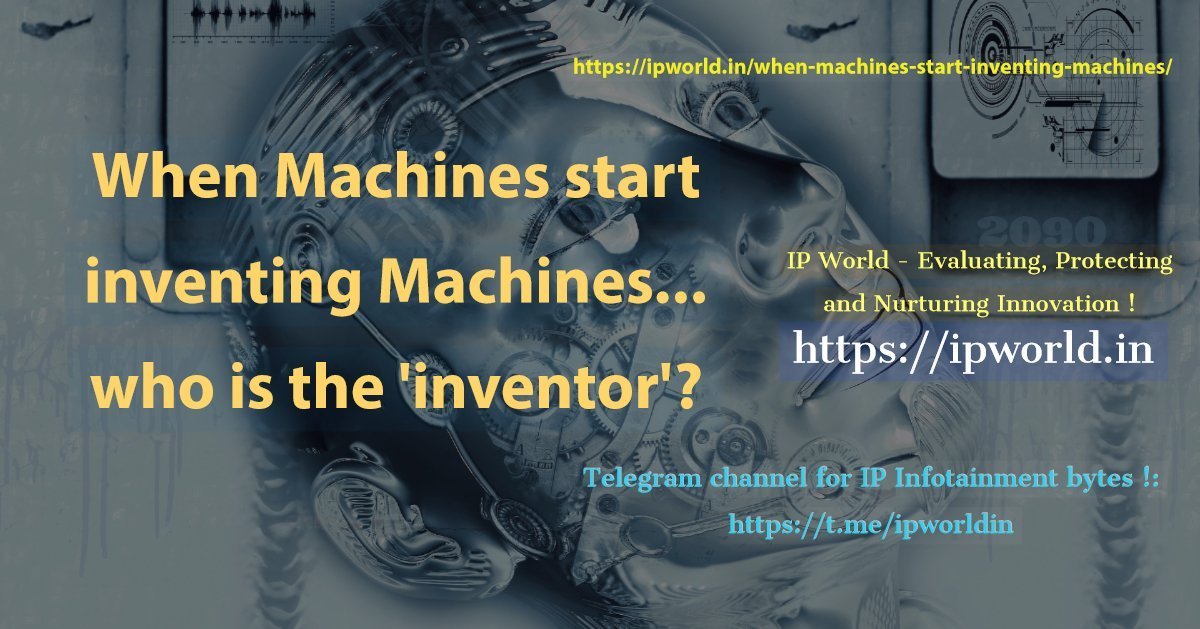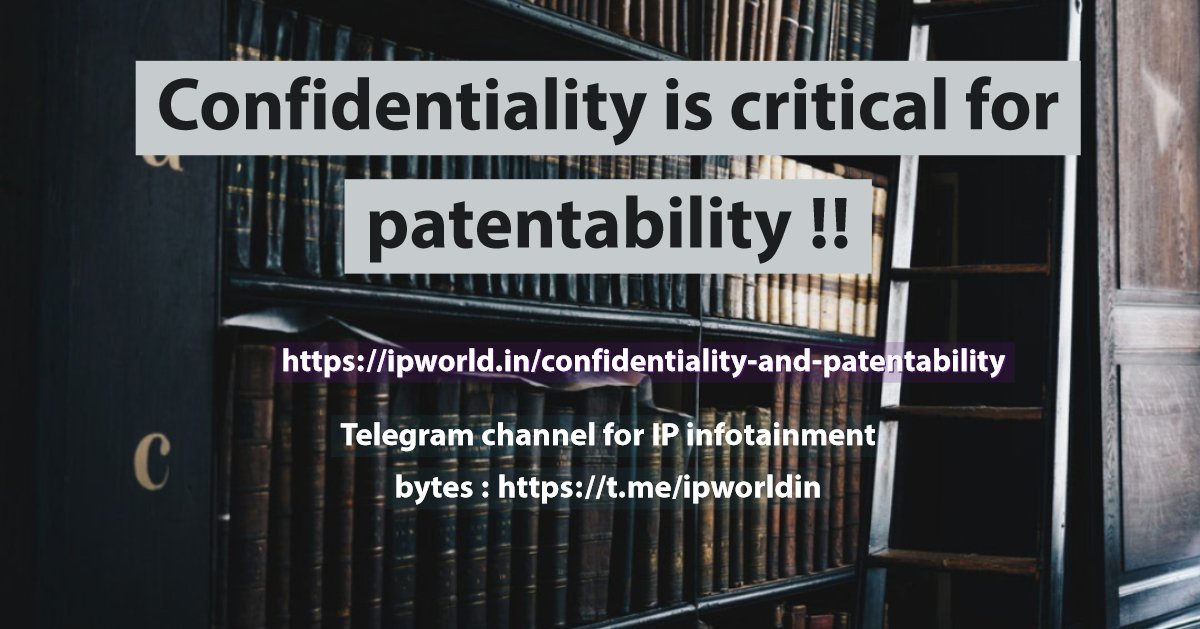Inspite of increasing awareness of intellectual Property (IP) amongst people, some of the fundamental terms are still either poorly understood, or used very loosely. This is aided no doubt by the media that has little understanding of various IP nuances. So much so that I have seen a patent application mentioned in the same breath and meaning as a copyright or a granted patent !
Intellectual Property – specifically patenting – is not an easy subject to comprehend. Legalese is used more often than not, which of course does not aid in understanding. At the same time, it is becoming increasingly critical to innovation ( Startups, for instance) that patenting is properly understood and exploited wherever possible.
Hence I am trying to set out – in simple terms hopefully- what is a patent to begin with ! Will be happy to provide clarifications to the extent possible and welcome your comments accordingly.
The Patents Rationale
The whole of patent regime globally has at its core a ‘quid pro quo’ arrangement. A patent grants ‘protection’ to the patentee ( patent holder ) for a limited tenure during which time the patentee has ‘rights’ enabling the patentee to commercially exploit the patent. Thus creativity and innovation is encouraged. After the tenure expires, others can in turn make use of the invention as set out in the patent without any obligation to the patentee, thereby further encouraging innovation.
With above as overarching objective, let us now look at what a patent is, and other relevant aspects with specific reference to Indian Patent Act. Mostly, provisions as set out herein hold valid globally.
But some variations can always be there !
What is a Patent ?
As far as the Indian Patent Act is concerned, Section 2(1)(m) of the Indian Patent Act defines a patent simply as:
(m) “patent” means a patent for any invention granted under this Act.”
Hence, one has to look further. Specifically. ‘invention’ is defined under Section 2(1)(j) as :
(j) “invention” means a new product or process involving an inventive step and capable of industrial application;
And ‘inventive step’ is further elaborated in Section 2(1)(ja) as:
(ja) “inventive step” means a feature of an invention that involves technical advance as compared to the existing knowledge or having economic significance or both and that makes the invention not obvious to a person skilled in the art;
Putting above together, a patent is granted for an ‘invention’ that can be product or a process that:
* has a technical advance as compared to the existing knowledge or
* has economic significance or
* has both and
that makes the invention not obvious to a person skilled in the art
The important condition here is that the invention should not be obvious to a person skilled in the art (PSITA). The PSITA ( or sometimes, POSITA- person ordinarily skilled in the art ) is a notional person, and the Examiner who examines the patent application at the patent office evaluates the patent application accordingly, considering the ‘prior art’ found by the Examiner. Simply put, prior art is anything – or information – that the Examiner can find that has relevance to the invention at hand. The degree of such relevance leads to whether the invention being examined is decided to be ‘obvious’ or not by the Examiner. If obvious, patent is not granted.
These requirements are usually expressed as ‘three parts test’ of patentability. The first test (utility / industrial application) seeks to decide how useful the invention will be when compared to existing similar products etc. This is, generally, an easy test to pass
The second test, termed as the ‘novelty test’ requires the invention to be innovative and new. The invention will be compared to prior art, or similar articles created in the past. This test may also be easy to pass since only if an exact prior art is found will the patent application be rejected.
However, the third test, termed as ‘non-obvious test’ is the toughest. Herein, invention is compared to prior art and differences found must not be obvious to PSITA. If the PSITA could have discovered the same invention it is considered obvious, and will not be granted a patent.
As can be readily understood, the non-obvious test involves a high level of subjectivity, wherein lies most of the disputes, problems and fun of the patenting world !
Further, some inventions may not be patentable to begin with, notwithstanding whether they clear the above tests or not !
Chapter III of the Indian Patent act elaborates upon this. One or more provisions of Section 3 are usually the most relevant.
Rights of a Patent Holder (Patentee)
Chapter VIII (Grant of patents and rights conferred thereby) of Indian patent Act elaborates upon this, amongst other aspects. Specifically, Section 48 says:
Rights of patentees
Subject to the other provisions contained in this Act and the conditions specified in section 47, a patent granted under this Act shall confer upon the patentee—
(a) where the subject matter of the patent is a product, the exclusive right to prevent third parties, who do not have his consent, from the act of making, using, offering for sale, selling or importing for those purposes that product in India;
(b) where the subject matter of the patent is a process, the exclusive right to prevent third parties, who do not have his consent, from the act of using that process, and from the act of using, offering for sale, selling or importing for those purposes the product obtained directly by that process in India:
As is clear from above, the right is not absolute. The Patent Act seeks a balance between rights of the patentee and the interest of general public. The overarching objective of the Patent Act is encouragement of technology and innovation. The Act also considers international conventions. While some exceptions of this right are covered in Chapter VIII itself, at other places as well exceptions are carved out.
But for most general purposes, protection of Section 48 holds. In this case, a third party that does not obey the provisions of S. 48 is said to be infringing’ on the rights of the patentee, for which patentee has legal recourse. An ‘infringement action’ lies against the infringer, the patentee can claim damages and penalties may be levied.
Hence a patentee has the right to decide who may – or may not – use the patented invention for the period during which it is protected. Patent owners may give permission to, or license, other parties to use their inventions on mutually agreed terms. Owners may also sell their invention rights to someone else, who then becomes the new owner of the patent.
Patent rights are usually enforced in courts that that, in most systems , (including Indian patent system) hold the authority to stop patent infringement. Conversely, a court can also declare a patent invalid upon a successful challenge by a third party. And typically, the first response of an infringer is to attempt invalidation of patent to begin with!
Further, patents have a ‘tenure’ and once such tenure expires, this protection ends, the invention enters the public domain, and can be used by any without any obligation towards the patentee. This is further elaborated as under.
Tenure of the Patent
The rights of the patentee are valid only during tenure of the patent. Section 53 of the Indian Patent Act sets it out as:
Term of patent
(1) Subject to the provisions of this Act, the term of every patent granted, after the commencement of the Patents (Amendment) Act, 2002, and the term of every patent which has not expired and has not ceased to have effect, on the date of such commencement, under this Act, shall be twenty years from the date of filing of the application for the patent.
Explanation.—For the purposes of this sub-section, the term of patent in case of International applications filed under the Patent Cooperation Treaty designating India, shall be twenty years from the international filing date accorded under the Patent Cooperation Treaty.
(2) A patent shall cease to have effect notwithstanding anything therein or in this Act on the expiration of the period prescribed for the payment of any renewal fee, if that fee is not paid within the prescribed period or within such extended period as may be prescribed.
(3) [Omitted]
(4) Notwithstanding anything contained in any other law for the time being in force, on cessation of the patent right due to non-payment of renewal fee or on expiry of the term of patent, the subject matter covered by the said patent shall not be entitled to any protection.
So, generally a patent has a tenure of 20 years from date of filing with the Patent Office, provided the patent has been kept in force by payment of renewal fees. If the patent is not in force due any reason (the invention has become ‘off patent’) the patentee no longer holds exclusive rights to the invention, and it becomes available for commercial exploitation by others.
A patent is a territorial right
It is important to understand that while ‘prior art search’ for patentability is a global search, the patent is granted only for the territory it is applied for. This concept is usually not well-understood and so needs further elaboration.
Suppose an inventor I seeks a patent in India for a product P based upon an inventive feature A of P. Inventor I files an application with the Indian Patent Office (IPO) claiming A as its inventive feature of product P
To determine if the invention is patentable to begin with, the Patent Office will search for feature A not only upon ‘art’ as available in India but globally. If, for instance a Seminar presentation elaborates upon same feature ‘A’ (maybe even in a different product, subject to exceptions) and that Seminar presentation has been made in, for instance, Tokyo, the presentation will act as ‘prior art’ and so, prevent grant of patent to inventor I.
However, that does not preclude the inventor I from producing P, provided there is no pending patent application or granted patent of another inventor already claiming feature A filed with the Indian Patent Office. This holds even if a patent has been granted on feature A in US for example.
In a similar manner, if I gets a patent in India but does not file a patent application in US, anyone in US can produce product P with inventive feature A without fear of any action by inventor I.
I hope above sets out, in a preliminarily easy manner, what a patent is and some basic aspects pertaining to same. Welcome all your comments and questions !




Dear Mr. Sodhi,
Well explained in layman’s language. You have opened vistas for innovative guys.
Great job.
Thank you. Very kind of you.